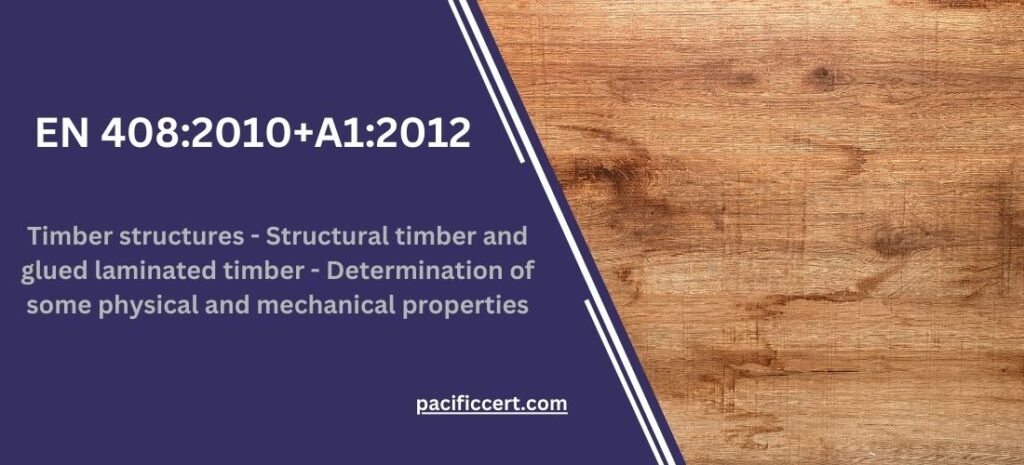
What is EN 408:2010+A1:2012-Timber structures – Structural timber and glued laminated timber – Determination of some physical and mechanical properties?
EN 408:2010+A1:2012 specifies methods for determining certain physical and mechanical properties of structural timber and glued laminated timber. These properties are important for assessing the strength, stiffness, and durability of timber products, and are used in the design and construction of timber structures.
The standard covers the following properties:
Density: the mass of the timber per unit volume.
Moisture content: the amount of water in the timber, expressed as a percentage of the dry weight.
Shrinkage: the change in dimensions of the timber due to drying.
Modulus of elasticity: a measure of the stiffness of the timber.
Modulus of rupture: a measure of the strength of the timber.
Shear strength: a measure of the resistance of the timber to sliding or deformation.
Compression strength: a measure of the resistance of the timber to being crushed.
Tension strength: a measure of the resistance of the timber to being pulled apart.
Brinell hardness: a measure of the resistance of the timber to indentation.
This standard provides detailed procedures for carrying out tests to determine these properties. Including the required equipment and sample preparation. The results obtained from these tests can be used to calculate design values for use in structural analysis and design.
Therefore, EN 408 can help to ensure that timber products used in construction are of high quality and have the required physical and mechanical properties. To meet the intended design and performance requirements
Requirements of EN 408:2010+A1:2012
Sampling: The standard provides guidance on how to select and prepare test samples from timber products. To ensure that they are representative of the product being tested.
Moisture content: The standard specifies procedures for determining the moisture content of the timber samples. Including sample preparation, measurement techniques, and the required equipment.
Density: The standard specifies procedures for determining the density of the timber samples. Including sample preparation, measurement techniques, and the required equipment.
Mechanical properties: This standard provides detailed procedures for carrying out tests to determine mechanical properties. Such as modulus of elasticity, modulus of rupture, shear strength, and compression strength. Also, tension strength, and Brinell hardness.
Reporting of results: The standard specifies requirements for reporting the results of tests. Including the units of measurement, the sample size, and any relevant testing conditions.
So, Compliance with EN 408 is important for ensuring that the physical and mechanical properties of structural timber and glued laminated timber are accurately determined and reported. And that these properties are suitable for use in structural design and analysis.
Therefore, The standard provides a reliable and consistent method for determining these properties. Which helps to ensure the quality and safety of timber structures.
Benefits of EN 408:2010+A1:2012
Improved quality control: EN 408 provides a reliable and consistent method for determining physical and mechanical properties of structural timber and glued laminated timber, which helps to ensure that these products are of high quality and meet the required standards.
Enhanced safety: Timber structures rely on the strength and stiffness of the wood to support loads and resist forces. Accurate determination of these properties through compliance with EN 408 helps to ensure that timber structures are safe and structurally sound.
Improved performance: By providing a standardized method for determining the properties of structural timber and glued laminated timber, the standard helps to ensure that these products perform as expected in structural design and analysis.
Compliance with regulations: Compliance with EN 408 helps to ensure that timber products meet the requirements of relevant regulations and standards. Such as the Eurocode standards for structural design.
Increased marketability: Compliance with the standard demonstrates a commitment to quality and safety, which can enhance the marketability of timber products and increase consumer confidence.
EN 408 provides a reliable and consistent method for determining the physical and mechanical properties of structural timber and glued laminated timber, which helps to ensure the quality, safety, and performance of timber structures.
Who needs EN 408:2010+A1:2012-Timber structures – Structural timber and glued laminated timber – Determination of some physical and mechanical properties?
Timber manufacturers: Manufacturers of structural timber and glued laminated timber need to comply with EN 408. To ensure that their products meet the required physical and mechanical properties.
Design engineers: Design engineers who work with timber structures rely on accurate and reliable data on the physical and mechanical properties of structural timber and glued laminated timber. So, EN 408 helps to ensure that this data is available and meets the required standards.
Architects: Architects who specify timber structures need to ensure that the products they specify meet the required standards for quality and safety, EN 408 helps to ensure that these standards are met.
Construction contractors: Contractors who build timber structures need to ensure that the products they use meet the required standards for quality and safety. Compliance with EN 408 helps to ensure that these standards are met.
Regulatory bodies: Regulatory bodies responsible for ensuring the safety and quality of timber structures rely on accurate and reliable data on the physical and mechanical properties of structural timber and glued laminated timber. So, Compliance with the standard helps to ensure that this data is available and meets the required standards.
Therefore, EN 408 is relevant to anyone involved in the design, manufacture, construction, or regulation of timber structures, and compliance with the standard is important for ensuring the quality, and safety. Also, performance of these structures
Pacific Certifications is accredited by ABIS, if you need more support with EN 408, please contact us at +91-8595603096 or support@pacificcert.com
Read About: EN 403-RESPIRATORY PROTECTIVE DEVICES









